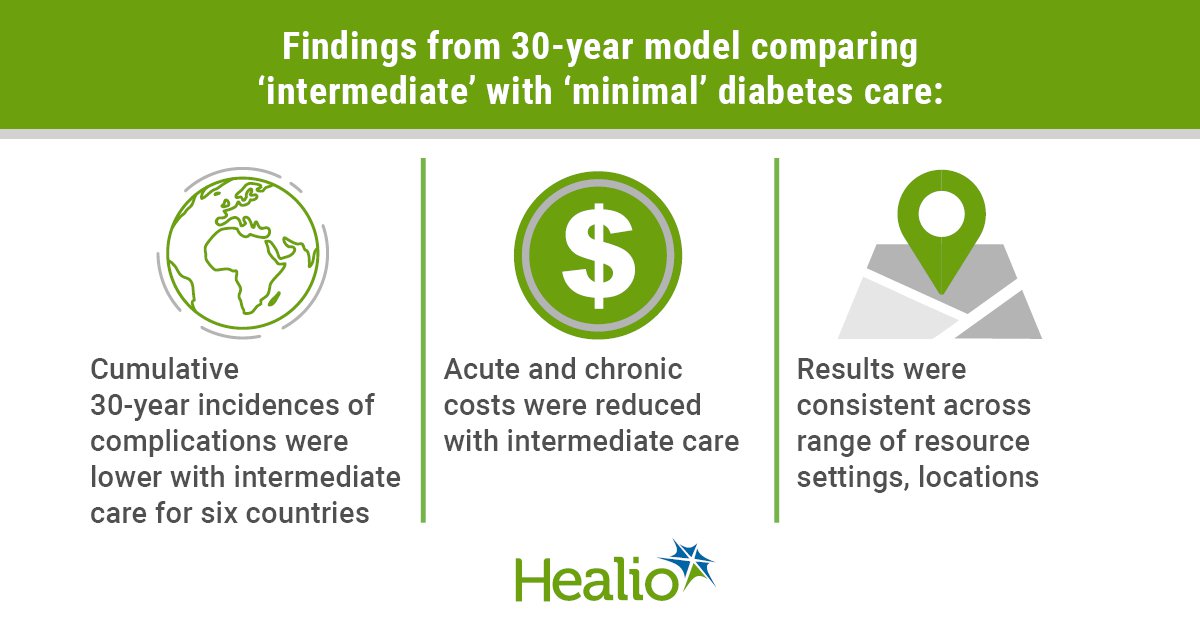‘Intermediate’ care reduces complications, mortality for type 1 diabetes in low-income countries
Low-income countries offering a level of intermediate diabetes care can cost-effectively reduce disease complication rates and mortality when compared with a minimal care framework, according to a 30-year modeling analysis published in Pediatric Diabetes.
“Many low- and middle-income countries are unable to provide the ‘comprehensive’ type 1 diabetes care established in international guidelines due to limited resources,” Graham Ogle, MD, general manager for Life for a Child, a program supporting youths with diabetes in 42 countries, and an adjunct professor of child and adolescent health at the University of Sydney, and colleagues wrote in the study background. “Consequently, the kinds of care that are offered to those with type 1 diabetes in these countries is often at a ‘minimal’ level. The bleak outcomes of this level of care include high mortality and the premature onset of devastating and costly chronic complications.”
New model
Ogle and colleagues developed a 30-year care model to determine whether an intermediate level of care could reduce morbidity and mortality while cost-effective in increasing healthy life years.
Researchers modeled two scenarios of care. Minimal care included government provision of human insulin given once or twice per day, two syringes per week, and provision of routine clinical care and hospital admissions, with rudimentary or no screenings for complications. Intermediate care consisted of human insulin delivered through a basal-bolus regimen, two to three blood glucose tests per day, point-of-care HbA1c testing, complications screening (weight, height, blood pressure, eyes, feet, urinary albumin, creatinine, lipids and treatment as indicated) and diabetes education (appropriate for ages, diabetes camps, peer and school support, and 24-hour emergency call services). The expected outcome from the intermediate care scenario was an HbA1c range of 8% to 9% across clinics.

“For the purposes of this study, ‘intermediate care’ with three blood glucose tests per day, resulting in a mean HbA1c level of 8.5%, was modeled as a realistic target in the three of the six countries with a relatively higher gross domestic product per capita: Bolivia, Sri Lanka and Azerbaijan (range, $3,394-$4,131),” the researchers wrote. “We have previously shown that this HbA1c level is achievable with this level of care in Bolivia. For the three countries with a relatively lower GDP per capita (Mali, Tanzania, and Pakistan; range, $824-$1,547), intermediate care with two blood glucose tests per day was modeled, with an outcome of a mean HbA1c level of 9%.”
Researchers developed a discrete-time Markov illness-death model, with age- and calendar-year-dependent transition probabilities, with inputs of 30 years of complications and standardized mortality rate data from the youth cohort in the Pittsburgh Epidemiology of Diabetes Complications Study, background mortality, and costs determined from international and local prices.
Healthy years gained
Cumulative 30-year incidences of complications were lower for intermediate care vs. minimal care. Thirty-year survival was 50.1% in Mali, 52.7% in Tanzania, 76.7% in Pakistan, 72.5% in Bolivia, 82.8% in Sri Lanka and 89.2% in Azerbaijan for intermediate care, whereas it was 8.5% in Mali, 10.1% in Tanzania, 39.4% in Pakistan, 25.8% in Bolivia, 45.5% in Sri Lanka and 62.1% in Azerbaijan for minimal care.
The cost of a healthy life year gained as a percentage of GDP per capita across the six countries was 141.1% in Mali, 110% in Tanzania, 52.3% in Pakistan, 17% in Bolivia, 41.8% in Sri Lanka and 15.6% in Azerbaijan.
The researchers noted that providing intermediate care was more costly than minimal care; however, this was only applicable to the increase in maintenance costs, whereas acute and chronic costs were reduced. Total costs per person for intermediate vs. minimal care, respectively, were $18,870 vs. $8,758 in Mali, $16,950 vs. $8,705 in Tanzania, $15,910 vs. $11,363 in Pakistan, $26,974 vs. $17,769 in Sri Lanka, $22,895 vs. $18,687 in Bolivia and $47,810 vs. $45,200 in Azerbaijan.
“The consistency of the results across a range of resource settings and locations suggests that the findings may generalize to other less-resourced countries,” the researchers wrote. “Overall, these findings could greatly strengthen local efforts made by health care professionals, policymakers and advocates who are working toward establishing guidelines-based type 1 diabetes care in their national health systems.” – by Regina Schaffer
Disclosures: The authors report no relevant financial disclosures.
